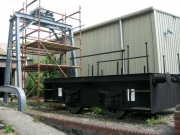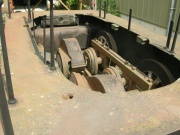Samuel Geoghegan: Locomotives









Samuel Geoghegan was Chief Engineer at the Dublin brewery of Arthur Guinness. Faced with problems arising with the brewery's locomotives on the 1 ft 10 inch gauge railway with its tight curves, he designed his own.
The brewery was connected to the 5 ft 3 inch gauge main line, and to avoid having to buy broad gauge locomotives, Mr Geoghegan came up with the idea of designing his narrow gauge locomotives to be lifted by a gantry and placed in a special 'haulage wagon', which was then propelled by the locomotive's wheels driving intermediate wheels, which in turn drove the wagon's wheels via a 1:3 reduction gearbox.
Working within very tight dimensional constraints, the design shows a great deal of ingenuity, all aspects being very carefully thought out. Earlier locomotives on the system suffered from having the valve gear very close to the ground, so on his locomotives, Geoghegan positioned the cylinders and reversing gear above the boiler, rather like the arrangement on traction engines, but with the cylinders sandwiched between the plate frames rather than being attached to the boiler.
The boiler was partly of the Ramsbottom type, and partly tubed. The first half had a cylindrical firebox, as in a Cornish boiler, with no need for stays. The forward half had fire tubes.
Steam brakes were provided.
The first example was built the Avonside Engine Co, and fifteen were built by William Spence and Son of Dublin between 1887 and 1921.
Several examples have been preserved. The one illustrated here is No. 23, with haulage wagon No. 4, at Amberley Working Museum, complete with gantry.

